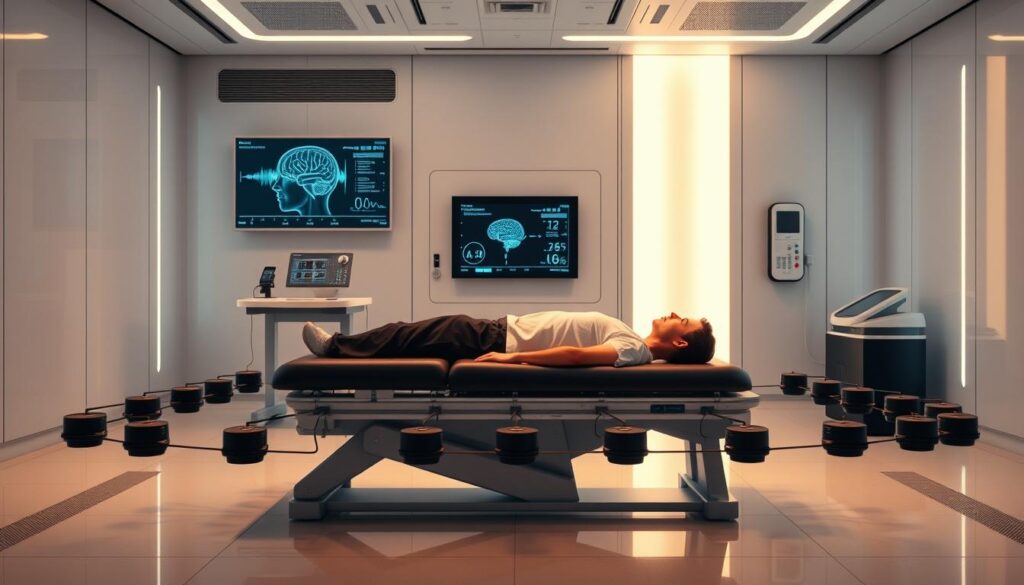As I address the common questions surrounding mert treatment, it’s essential to understand the nuances of insurance coverage for this therapy. Currently, rTMS is FDA-cleared for the treatment of Depression, and our clinic provides the necessary paperwork for patients to submit to their insurance company for reimbursement.
Some patients have reported receiving reimbursement for EEGs, clinical evaluations, and treatment, depending on their health coverage. The brain treatment involves various factors that determine insurance coverage, which can vary depending on the condition being treated and whether the application is FDA-cleared.
Key Takeaways
- MeRT treatment coverage varies depending on the condition being treated and FDA clearance.
- Insurance reimbursement for MeRT treatment is possible, depending on health coverage.
- Our clinic assists patients in navigating insurance questions related to MeRT treatment.
- Factors determining insurance coverage for brain therapy treatments like MeRT differ from traditional covered treatments.
- Patients can expect to receive necessary paperwork for insurance reimbursement.
Understanding MeRT Treatment
As we delve into the world of MeRT treatment, it’s clear that this therapy is designed to address the complexities of neurological conditions with a personalized touch. At Brain Treatment USA, we understand the importance of choosing the right therapy for a loved one with autism or other neurological disorders.
What is Magnetic e-Resonance Therapy (MeRT)?
MeRT, or Magnetic e-Resonance Therapy, is an innovative brain treatment that utilizes gentle magnetic stimulation to target specific areas of the brain based on individual neurological patterns. This treatment approach analyzes and treats brain wave patterns to promote improved neurological function. By using magnetic e-resonance, MeRT therapy provides a unique method for addressing various neurological conditions.

How MeRT Differs from Standard TMS
One of the key distinctions of MeRT lies in its personalized approach. Unlike standard TMS (Transcranial Magnetic Stimulation), which follows a more generalized protocol, MeRT treatment is tailored to the individual’s specific neurological needs. This customization makes MeRT uniquely effective for various conditions compared to conventional magnetic stimulation therapies. By focusing on the individual’s brain wave patterns, MeRT provides a more nuanced form of therapy.
The distinction between MeRT and other neuromodulation therapies, including standard TMS, is significant. MeRT’s individualized approach ensures that the treatment is as effective as possible for each person’s condition.
Is MeRT Covered by Insurance?
Understanding the insurance coverage for MeRT is crucial for those considering this treatment. The question of whether MeRT is covered by insurance depends on several factors, including the specific condition being treated and the patient’s insurance provider.
Currently, rTMS, a treatment related to MeRT, is FDA-cleared for the treatment of Depression, specifically major depressive disorder. This clearance impacts insurance coverage, as many insurance providers are more likely to cover treatments that are FDA-cleared.

Insurance Coverage for FDA-Cleared Applications
For FDA-cleared applications like major depressive disorder, the likelihood of insurance coverage is higher. At the end of the treatment, our clinic provides all necessary paperwork so that patients can submit insurance claims for reimbursement. Some patients have reported receiving reimbursement for EEGs, clinical evaluations, and treatment, depending on their health coverage.
The process of submitting insurance claims can be complex, but our clinic assists patients in navigating this process to ensure they receive the reimbursement they are eligible for.
Reimbursement Options for Other Conditions
For conditions that are not FDA-cleared for MeRT treatment, the situation is more nuanced. While some insurance providers may offer partial coverage or reimbursement for certain aspects of the treatment, others may not cover it at all. Medicare patients, for instance, have reported that their coverage does not provide reimbursement for the MeRT treatment itself.
To determine the extent of their coverage, patients should directly contact their insurance providers and ask specific questions about MeRT coverage. It is also essential to understand the difference between coverage for the treatment itself and diagnostic procedures like EEGs, which may be more commonly covered.
Our clinic is committed to helping patients understand their insurance options and navigating the reimbursement process. We provide detailed information and support to ensure that patients can focus on their treatment without undue financial stress.
The Insurance Submission Process
To ensure that your MeRT treatment is covered by insurance, it’s essential to understand the insurance submission process. Our team is dedicated to helping you navigate this process.
The insurance submission process involves several steps that are crucial for successful claims. First, our team works closely with you to gather all necessary documentation. This includes diagnostic codes, treatment protocols, and physician statements.
Documentation Required for Insurance Claims
To submit a successful insurance claim for MeRT treatment, specific documentation is required. This includes:
- Diagnostic codes that justify the medical necessity of MeRT treatment
- Detailed treatment protocols outlining the MeRT treatment plan
- Physician statements supporting the use of MeRT for your condition
Our team will guide you through gathering these documents to ensure a smooth submission process.
Working with Our New Patient Coordinator
Our new patient coordinator plays a vital role in the insurance submission process. They will work directly with you to gather the necessary information and documentation. To begin the insurance verification process, you can call our new patient coordinator at 210-346-0282 or fill out the form on our website.
By working together, we can maximize your chances of insurance coverage by properly documenting the medical necessity of your MeRT treatment.
Payment Options for MeRT Treatment
When considering MeRT treatment, it’s essential to explore the various payment options available. At our institution, we strive to make MeRT treatment accessible to those who need it.
Self-Pay Options and Payment Plans
We offer flexible payment plans designed to make MeRT treatment more manageable. Patients can choose from various self-pay options, including monthly payment plans and package discounts. Our team works closely with patients to create a personalized payment plan based on their specific treatment plan needs.
To discuss personalized financial arrangements, patients can call our new patient team. We understand that each patient’s situation is unique, and we are committed to finding a solution that works for them.
- Monthly payment options to reduce financial strain
- Package discounts for committed patients
- Personalized payment plans based on individual needs
Accepted Payment Methods
We accept a variety of payment methods to make it easier for patients to manage their MeRT treatment costs. These include all major credit cards such as Visa, MasterCard, American Express, and Discover. Patients can also use health savings accounts and other financial options.
| Payment Method | Description |
|---|---|
| Credit Cards | Visa, MasterCard, American Express, Discover |
| Health Savings Accounts | Using pre-tax dollars for medical expenses |
| Other Financial Options | Discussed on a case-by-case basis |
To establish payment arrangements, patients can fill out the necessary forms prior to beginning their treatment course. Our team is dedicated to making the payment process as smooth as possible, ensuring that patients can focus on their MeRT treatment and achieving a healthier brain.

MeRT Treatment Process and Evaluation
The journey to MeRT treatment begins with a thorough evaluation of the brain. This initial step is crucial in determining the suitability of the treatment for the patient.
Initial Evaluation and QEEG/EKG Assessment
The MeRT treatment process starts with an initial evaluation, which includes a comprehensive brain assessment using QEEG (Quantitative Electroencephalography) and EKG (Electrocardiogram) testing. These tests create a detailed brain map that guides the personalized treatment plan. The QEEG/EKG assessment helps identify the areas of the brain that require attention, allowing for a tailored approach to treatment.
The initial evaluation establishes a baseline for measuring treatment progress and determining the optimal treatment parameters. This baseline is crucial for assessing the effectiveness of the MeRT treatment and making necessary adjustments.
Personalized Treatment Plans
Personalized treatment plans are developed based on the qEEG and EKG findings. The data collected from these tests enables healthcare professionals to create a customized treatment plan that addresses the unique needs of each patient’s brain function. This personalized approach ensures that the treatment is tailored to the individual’s specific condition.
The treatment plan is designed to address the specific brain function needs identified during the initial evaluation. By using the data from the QEEG/EKG assessment, healthcare providers can develop a treatment protocol that is optimized for the patient’s condition.
Treatment Duration and Frequency
The typical treatment duration and frequency for MeRT treatment is five days a week. The total number of sessions recommended varies depending on the patient’s condition and response to treatment. The treatment protocol is adjusted based on ongoing evaluation and patient response throughout the MeRT treatment course.
To ensure the safety and efficacy of MeRT treatment, it is essential to consider the absolute contraindications. The following table outlines the conditions that may prevent a patient from undergoing MeRT treatment:
| Contraindication | Description |
|---|---|
| Pacemaker | A medical device that regulates heart rhythm |
| Defibrillator | A device that prevents sudden cardiac death |
| Vagal Nerve Stimulator | A device used to treat epilepsy and depression |
| VP Shunt/Magnetic intracranial shunts | Devices used to treat hydrocephalus |
| Deep Brain Stimulator | A device used to treat neurological disorders |
| Cochlear implant | A device used to treat hearing loss |
| Pregnant or breastfeeding | Conditions that may affect treatment safety |

Conclusion: Making MeRT Treatment Accessible
As we conclude our exploration of MeRT treatment, it’s clear that this innovative brain therapy offers new hope for patients with various conditions. Our discussion has highlighted the importance of understanding insurance coverage and payment options for this groundbreaking therapy.Making MeRT Treatment AccessibleWe are committed to making MeRT treatment accessible to patients through various financial options and insurance assistance. Our team works closely with patients to navigate both the clinical and financial aspects of beginning MeRT treatment. By working with ournew patient coordinator, patients can ensure a smooth transition into their treatment plan.
Patients can track their progress and results throughout the treatment process, with regular evaluations to measure improvements. Our team supports patients throughout their treatment journey, from initial questions about MeRT to completing the full treatment protocol.
For interested patients, the next steps include filling out forms or calling our new patient coordinator to begin the evaluation process. We address common questions about MeRT treatment results, including typical improvements seen in various conditions and how long these results typically last.
Complementing Other TherapiesMeRT can complement other therapies and treatment plans, particularly for children with autism and other neurological conditions. Our team is dedicated to making this innovative brain treatment available to those who can benefit from it, regardless of financial circumstances.
By providing personalized treatment plans and supporting patients throughout their treatment journey, we aim to make MeRT treatment a valuable resource for those seeking improved outcomes.
